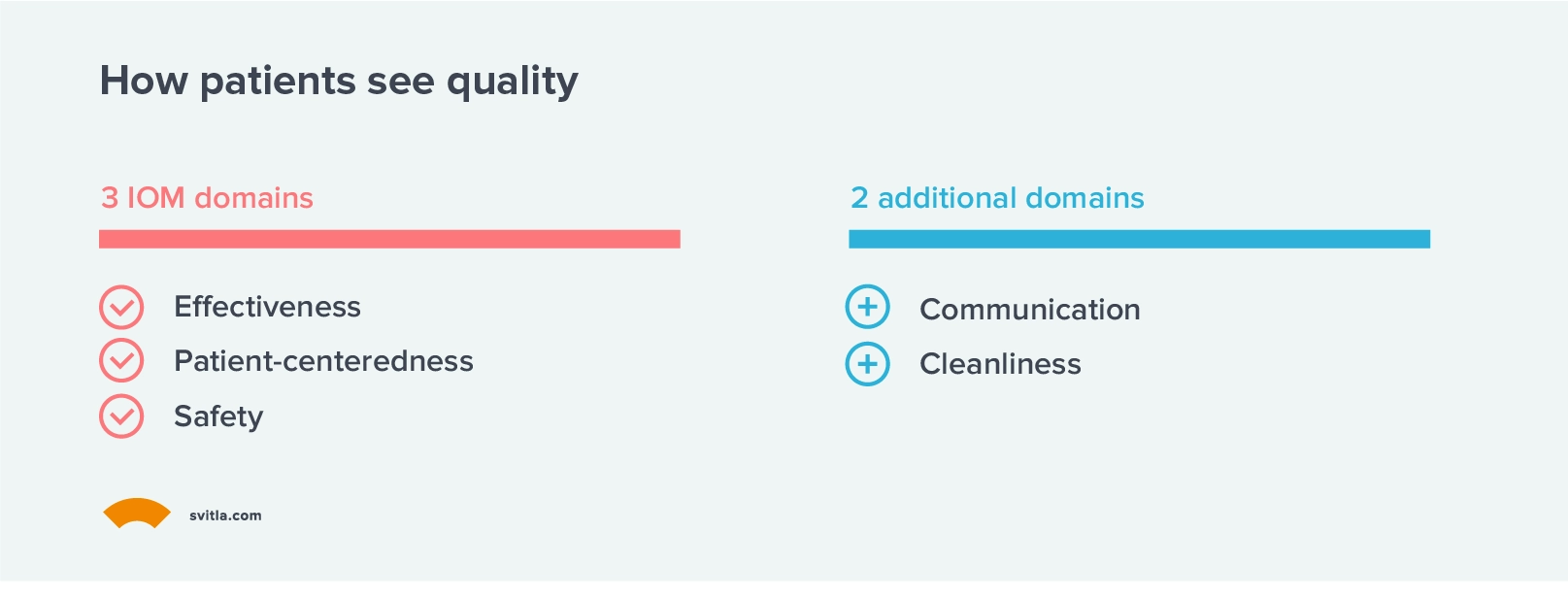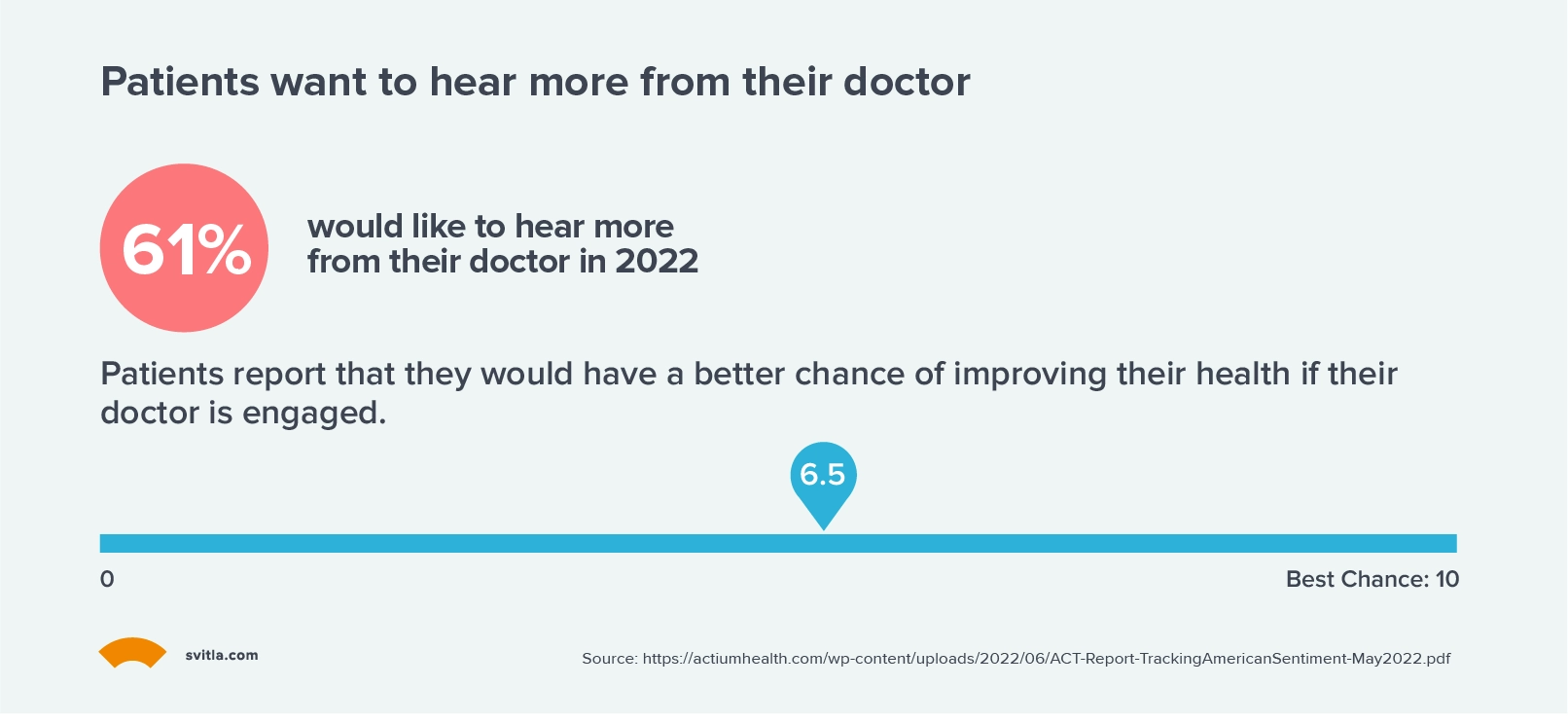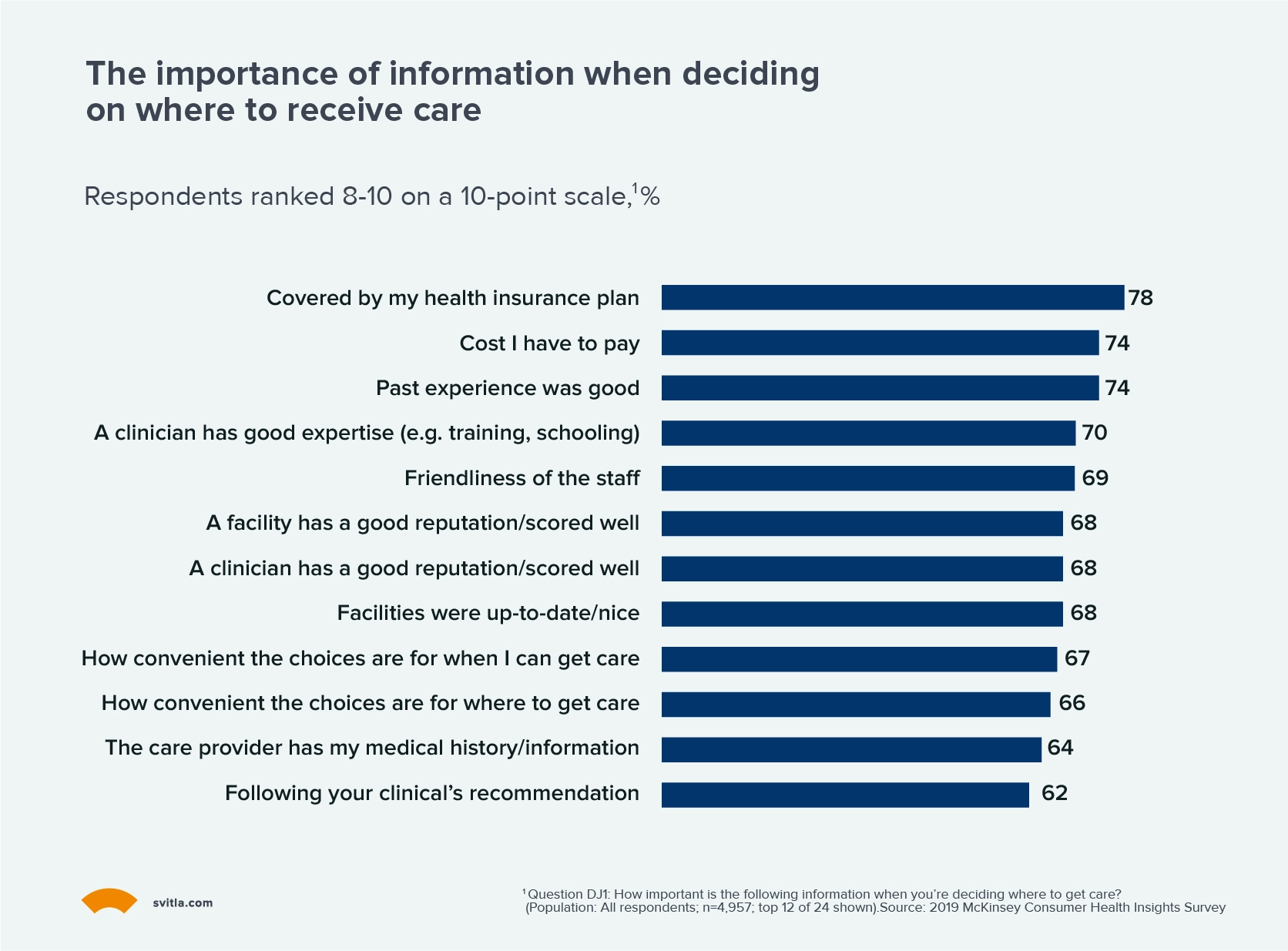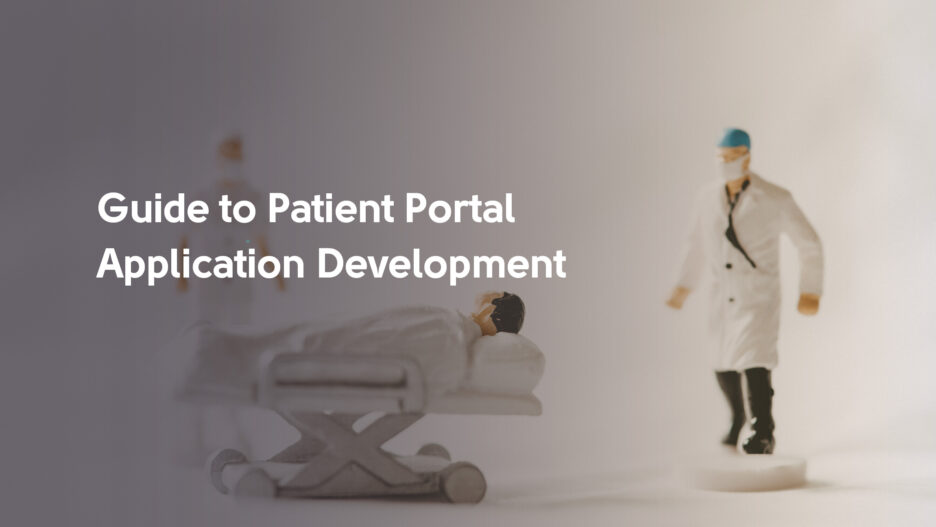Not so long ago, visiting the doctor’s office was the only way to get a consultation, obtain a prescription, or check your latest lab results.
Today, however, 3 in 4 Americans are offered online access to their medical records by their healthcare provider or insurer. And many providers even go further, offering access to virtual appointments, e-prescriptions, medication trackers, and a wide range of other tools for personal well-being, all through patient portal applications.
In this telemedicine app development guide, we analyze the patient portal software market, zooming in on the key players and in-demand features both patients and hospital administrators would like to have in new products.
Patient Portal Software Market: Key Players
The total addressable market for patient portal software stood at $2.41 billion in 2021 but is set to expand to $11.74 billion as the demand for digital healthcare services increases.
In the US, several software vendors hold the top spots on the market. Every year KLAS research selects the best healthcare software and IT solutions from its database of 900+ vendors. The 2023 Best in KLAS report highlights the following players in the patient portal segment for their superb usability, wide range of integrations, and solid selection of add-on features.
MyChart by Epic
Epic Systems is a veteran healthcare software vendor, serving US institutions since 1979. The company holds 29% of the EMR software market share in the US, and over 250 million patients have an electronic record in Epic.
Built atop its advanced EMR system is Epic’s sister product — MyChart. MyChart is a patient portal app used by 160+ million patients worldwide. Available as a user-friendly mobile app, MyChart helps evaluate digital patient experience via convenient appointment scheduling, transparent bill management, and remote patient monitoring via integration with home monitoring devices.
Texas Children's Hospital used MyChart to improve appointment availability. With the Fast Pass feature, patients could be seen 27 days sooner on average, and one department improved availability by 90 days.
UCHealth in Colorado, in turn, improved price transparency at its hospitals by using MyChart to provide line-by-line estimates of medical procedure costs before these are administered.
Key features:
- Online appointment scheduling and management
- Virtual appointments with healthcare professionals
- Remote patient monitoring
- Access to preventive care
- Symptom checker
- Medication refills
- Automatic check-in at the clinic
- Instant access to healthcare records
- Online payment options
- Upfront cost estimates
- Integrations with popular CRM, EMR, and EHR software
Meditech
Meditech is another well-established player in the US EMR market, operating since the early 1970s. The company’s suite of software products covers all front-, middle-, and back-office processes, including clinical documentation management, case coordination, secure record storage, claims management, payment copay collection, and more. Meditech also offers specialized products for genomic and clinical analysis research.
Patient Connect is the flagship product for patient relationship management. Fully cloud-based, the platform helps administrators easily connect with patients through their preferred channels and provides them with self-service tools for appointment scheduling, check-in, and easy payment processing.
With Patient Connect, St. Luke’s Health System saved each scheduler 5-7 hours daily during the busy COVID-19 vaccination period. King’s Daughters Medical Center, in turn, attributes a 39% reduction in ED door-to-discharge time and a 250% reduction in visits lasting over 6 hours to the app. Both of these improvements happened against the backdrop of a 15% increase in patient volumes, while staff levels remained the same.
Key features:
- Online appointment scheduling
- Contactless check-in
- Insurance verification
- Virtual visits
- Health summaries
- Discharge instructions
- Access to lab results and radiology reports
Greenway Health
Greenway Health flagship product is a cloud-based, interoperable EHR system, which can be adapted for multiple practices (Cardiology, OB-GYN, Pediatrics, Primary Care, and many more).
The platform includes several modules that can be bundled or used as a standalone product. Patient Engagement module is one of them. The solution includes an intuitive web patient portal and a companion mHealth app with secure messaging, video consultation, and payment processing features.
Patients can effortlessly access available health records, contact the provider with medical or payment questions, request prescription refills, or book a new appointment. With Greenway Health, institutions can automate many menial admin tasks and proactively engage with the patient population through a unified interface.
Coeur d'Alene Pediatrics, for example, credits its patient-centered medical home (PCMH) recognition to extensive usage of Greenhealth products, including its EHR and patient portal app.
Key features:
- Appointment scheduling
- Appointment reminders
- e-Prescription refills
- Secure Messaging
- Access to educational materials
- Payment management
Main Features for a Patient Portal Application
Patients have come to expect superior quality and services from healthcare providers, whether the interaction happens in person or digitally.
According to the 2023 Experience Perspective study from NRC Health, patients define “quality” through multiple lengths.
Patients across age brackets ranked effectiveness as the most important component of quality, with older males having a slightly higher preference towards this quality compared to younger women.

Source: 2023 Experience Perspective study
To secure high adoption rates, vendors should focus on meeting these criteria when considering telemedicine app development.
Our team has created a list of the most in-demand features for new patient portal software based on the market analysis.
Appointment Scheduling and Management
Online appointment scheduling dramatically decreases the efforts required both from patients and healthcare professionals. Instead of long hold times or casual walk-ins, patients can conveniently select a suitable time slot through mobile and web apps and receive instant confirmation and a reminder before the visit.
Almost 80% of all US consumers would schedule care online if given the option, and 75% of Millennials scheduled their last appointment online.
In fact, consumers value online appointments to the extent that 58% of Millennials and 64% of Gen X patients will switch providers to get access to online booking features.
Administrators, in turn, don’t have to spend as much time manning the phone or dealing with a sudden influx of patients at the front office. The best patient portal software also allows users to collect extra information prior to the visit (e.g., details about allergies or current medication schedule) to speed things up during patient check-in.
| Benefits for Patients | Benefits for Healthcare Providers |
|
|
That said, many telemedicine solutions available on the market don’t fully meet users’ expectations. Some 70% of patients said that when recently trying to schedule an appointment via an online patient portal, they were redirected to using a phone (which most found frustrating). The majority of patients (54%) would also be more inclined to use an online scheduling tool if the booking experience was easier.
The data suggests gaps in patient portal user experience (UX). Healthcare providers still need better front-office tools for patient intake, scheduling, and management — and your new product can provide these capabilities.
For example, Svitla Systems has recently helped a healthcare company launch a new digital patient portal, offering access to easy online appointment booking, prescription management, and medical records reviews — and integrated the patient-facing solution with a backend system for hospital administration.
Sample functionality for a custom patient portal app
- Fully online appointment scheduling and confirmation
- Pre-programmed appointment reminders (via preferred channel)
- Flexible schedule management by the administrator
- Appointment waitlists and notifications about open slots
- Online check-in process (questionnaires, e-form signatures)
- After visit summaries and care instructions
Online Medical Consultations
During the past few years, telehealthcare services have consistently increased. About 20% of patients in the US opted for teleconsultations last year, which is a 5% increase compared to the year before.
Government officials have also extended Medicare coverage of telehealth through 2024, with private insurance companies following the lead. This would also further stimulate increased usage among patients.
“We are going to see a slow rise from the 20% to 25% we are currently [seeing], moving up maybe toward that 70% again, but in a more natural course where the usability is improving and where the culture is slowly getting there. It's going to take another five years or so to see that go up to the 50% to 70% rate that we’ve seen during the early part of the pandemic”.
– Eyal Zimlichman, MD, Chief Innovation and Transformation Officer at Sheba Medical Center
For software vendors, a more positive sentiment from patients and doctors translates to new opportunities for telemedicine app development.
Chronic illness management is one promising area of product development. Over 133 million Americans live with at least one chronic disease, requiring regular checkups. Yet, only 50% of patients with chronic medical conditions follow the prescribed medication schedule.
People in remote, rural communities also often postpone their visits due to the inability to travel. Online consultations can help eliminate the time, transportation, or mobility issues that prevent patients from getting timely care.
In addition, with a projected physician shortage of 37,800 at present and 124,000 by 2034, telehealth applications can help improve staffing schedules for healthcare institutions, allowing organizations to operate with smaller but more effective teams.
Sample functionality for a custom patient portal app
- Advanced search features for doctor look-up
- Medical information sharing (photos, details about symptoms, etc.)
- Secure video and voice calls
- Integrated payment processing
- Remote patient monitoring features
E-Prescriptions and Refills
A good fraction of in-person doctor visits has to do with prescription requests and renewals. Over 6.7 billion drug prescriptions were dispensed last year.
These routine visits are both time-consuming for the patients and healthcare professionals. Patient portals can help automatically revise, renew, and track prescriptions, even for regulated substances, thanks to the recent extension of telehealth provisions by the Drug Enforcement Administration.
By adding e-prescriptions and automatic refill requests to your patient portal, you can dramatically improve the quality of patient care. Almost 4 in 10 Americans have to wait overnight or over the weekend for doctors to send their prescriptions to the pharmacy, according to iPrescribe. The majority (72%) also want their doctors to use a mobile e-prescribing tool when they’re away from the office to receive their refills faster.
Modern patient portal software allows clinicians to digitally prescribe new drugs in a matter of clicks, using stored patient information. Patients, in turn, can easily reorder meds online through integrations with e-pharmacies.
FDB Vela by First Databank, for example, fully automates the e-prescription process through secure exchanges of medical information, benefits data, and clinical evidence between prescribers, payers, pharmacies, and other market participants.
Sample functionality for a custom patient portal app
- e-Recipe creation and filling to pharmacy
- Pickup or delivery scheduling
- Automatic prescription expiry reminders
- Medicine adherence tracker
Personalized Health Information Summaries
When dealing with a complex healthcare system, patients may not understand all the information provided to them. Many are misinformed or unaware of the therapeutic options, preventive healthcare measures, and available benefits. 50% of US patients have low health literacy.
Lack of timely access to verified information and personalized guidance, in turn, increases the rates of medication misadherence, hospital readmissions, and delayed primary care.
Patient portals help implement better person-centered care by providing users with easy access to personal healthcare information and extra tools for following discharge instructions, staying atop immunization requirements, and scheduling recommended routine check-ups. Such software has already been clinically proven to improve ongoing disease management and prevention.
Integrations with wearable devices and mHealth products can also help healthcare practitioners collect more patient information and recommend different care and wellness options.
However, most patients feel that digital health experiences aren’t up to their standards. A survey by NTT Data Services found that patients want better experiences when it comes to accessing family records (80%), reviewing test results (79%), paying medical bills (75%), and filing a prescription (74%). Clearly, there are unfulfilled expectations that a custom patient portal could address.
Sample functionality for the custom patient portal app
- Access to personal healthcare records
- Overview of current health issues
- Prescribed plan of care
- Visit summaries and history
- Immunization history and calendar
- Test results and radiology images
- Preventive care recommendations
- Personalized healthcare questionnaires
- Symptom checker
- End-of-life planner app
- Integration with wearable apps (Withings, Fitbit, and Apple Health)
Patient Communication and Engagement
Apart from having self-service access to healthcare information and recommendations, patients also come to expect better communication.
Two-thirds of patients have questions after a provider encounter and one in five patients has new questions following their appointment, according to a Wolters Kluwer survey. Among these, 49% believe they’d have fewer follow-up questions if the provider offered them more educational materials.
Yet, over 60% of patients don’t get sufficient engagement from their healthcare providers, although 30% expect them to be on top of their healthcare (e.g., ensuring they attend preventive appointments). That’s not surprising given that access to health history and details of their diagnoses is often restricted.

Patient portal applications improve patient engagement with their healthcare providers by providing easier access to electronic health records, reliable healthcare information, educational materials about preventive care, and easier connectivity with doctors (through online chats and message portals).
Research shows that consistent patient engagement and shared decision-making lead to better patient/clinician relationships, higher adherence to advice, and increased satisfaction with the outcomes.
Moreover, proactive communication also helps healthcare institutions save on operating costs. Clinical trials in the United Kingdom and Sweden found that medicine waste can be reduced by 30% if patients are offered an option to discuss their concerns (on top of receiving standard one-time instructions) when starting a new treatment.
Sample functionality for custom patient portal app
- Unified access to all medical documents on file
- Online message center
- Personalized digest of educational materials
- Online requests for referrals
- History of previous clinic calls and visits
Online Payments and Insurance Management
Medical costs are steep, and not all patients are financially prepared for upcoming bills. However, 45% of patients regularly struggle to determine the costs of a medical service and 60% want more information when deciding where to get care, a McKinsey study found.
Among the most important factors, patients rank insurance coverage, service costs, prior experience with the provider, and levels of qualifications of the selected provider. Many prioritize lower costs even if it means certain trade-offs like traveling to a farther location or the clinicians’ reputation.

Overall, 75% of patients will look up the cost of medical procedures online and the ability to obtain a clear estimate will impact their choice of provider.
For hospitals, greater price transparency and preliminary estimates, based on the patient’s insurance plan, can dramatically reduce the volume of delinquent bills and complexities in claims management.
Integrated payment processing of co-pays and out-of-pocket expenses via the portal app can also reduce the time spent in the office, increasing patient throughput at the facility. Digitized billing also reduces the errors in proper coding and accelerates revenue cycles.
Sample functionality for the custom patient portal app
- Access to insurance coverage information
- History of claims, referrals, and benefits information.
- Paperless billing and online payment processing
- Online co-pay payments
- Payment plan setup and configurations
- Online price estimates for procedures
Challenges of Telemedicine App Development
Medical software development, in general, is a complex field requiring both technological know-how and knowledge of industry regulations.
If you’re considering patient portal app development services, look for providers with proven knowledge in the domain and a set of case studies from other healthcare institutions.
Below are the common challenges to keep in mind.
Regulatory and Compliance Requirements
The two main standards that apply to patient portals (and healthcare software at large) are:
- Federal meaningful use (MU) criteria
- Health Insurance Portability and Accountability Act (HIPAA)
Meaningful use (MU) criteria traditionally apply to EHR systems. Under the Stage 2 MU objectives, patients need the functionality to access health information online and the ability to exchange electronic messages securely — hence, the patient portal should meet these requirements.
HIPAA-compliant software, in turn, must meet a broader range of criteria regarding data access, data storage, prevention of accidental data deletion, electronic data exchanges, and general access and identity management of users. Most of these provisions apply to custom patient portal development.
Integrations with Other Systems
Patient portals serve as a digital “front” for accessing data from other healthcare systems: EHR/EMR, Radiology Imaging System, and custom relationship management (CRM) software. In many cases, especially with legacy solutions, data integrations can be complex, requiring experience with different API standards. Varying data formats and different communication protocols used by the adopted medical software may also require wider ranges in your data management infrastructure.
At the same time, many patient portal features can be powered by third-party integrations (e.g., with popular video conferencing platforms, online payment processors, or patients’ wearable devices). These must also be implemented appropriately and secured to avoid cybersecurity risks.
Poorly configured integrations with third-party services have already resulted in data breaches. In 2023, BayCare Clinic accidentally disclosed the healthcare information of 134,000 patients due to using pixel technology by its partner, Aurora Health. The breach happened when users logged into the clinic’s patient portal while being logged into either their Google or Facebook accounts.
Data Security
Patient portal applications contain valuable data and are a lush target for cyber-criminals. In 2023, an average of 58.2 data breaches occurred monthly among healthcare institutions, leading to regulatory fines and substantial reputational losses.
Poorly secured patient portals often serve as a gateway for cyber-criminals. And thanks to multiple integrations with other downstream systems, the scale of such breaches can be large.
To mitigate these risks, follow security-by-design principles when developing a custom solution. Implement secure sign-up and authentication process for new users (forced strong password policy, multi-factor authentication). Implement secure log-in monitoring and device intelligence to confirm the user’s identity. Identity-proofing questions should be triggered when something doesn't add up.
Conclusion
Digital healthcare experience is becoming the norm, and patients actively seek extra information and services from their healthcare providers.
Patient portals have been proven to reduce the number of emergency department visits and volume of hospital readmissions, decrease healthcare service usage, and improve adherence to medical appointments.
Patients using portals also report better health outcomes, especially with chronic illnesses, higher satisfaction with medical services, and higher levels of safety.
If you aim to deliver more personalized and effective care in 2024, custom patient portal app development should rank high on your agenda.
Get in touch with Svitla Systems to receive extra information about our medical software development services.





